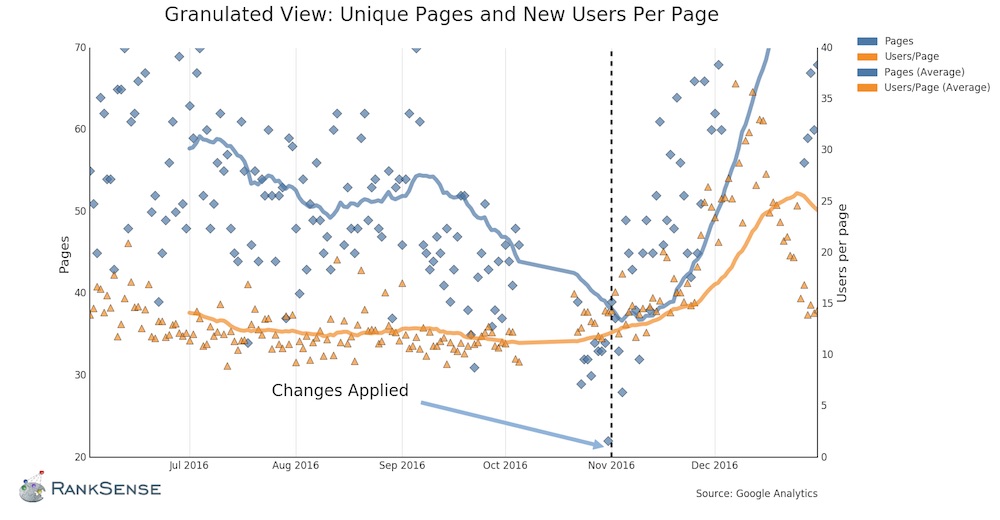When organic traffic drops, it’s typically caused by fewer pages performing, or fewer visitors per page, or both. If there are fewer pages performing, there potentially are indexing problems. Common errors that I’ve seen are: Missing, incorrect, or incomplete URL mappings — lower page reputation; Massive URL consolidations leading to a smaller site — less content; New infinite crawl spaces (explained below) — fewer pages indexed; New infinite scrolling that is not SEO friendly — less content; Backlink penalties — lower page reputation. And here are the key places I quickly collect evidence: 404 errors in Google Search Console; Landing page organic traffic report in Google Analytics; Index status and XML sitemaps reports in Google Search Console; URL parameters settings in Google Search Console; Latest links report in Google Search Console. Those questions should determine what data and evidence to collect, and how to process it and visualize it. But the site started to experience a downtrend in organic search traffic before then, at the beginning of September, as year-over-year organic traffic was down approximately 20 percent. But, regardless, a couple of weeks after the launch, organic traffic dropped even further, by roughly 40 percent over the previous year. I didn’t need to look at content issues, but, instead, I could focus on indexing. So we looked into Google Search Console URL parameters — Search Console > Crawl > URL Parameters — to find indications of an infinite crawl space. We clicked on the pages reported as errors, and as we expected the correct pages redirected and loaded correctly.
During a website redesign, re-platform, or domain change, it is not uncommon to see a reduction in organic search traffic. The panic generally starts weeks after trying one thing after another and the traffic does not return.
In this post, I’m going to walk you through a process I use to accelerate the recovery of this painful problem.
Identify the Root Causes
Instead of running a website through a full search-engine-optimization checklist, which generally takes a lot of valuable time, I prefer to focus on the 20 percent of glitches that are likely causing 80 percent of the problem. This approach allows for faster, incremental recovery, leaving time to address the other issues later.
When organic traffic drops, it’s typically caused by fewer pages performing, or fewer visitors per page, or both. I first try to determine which of these is the issue. If there are fewer pages performing, there potentially are indexing problems. If we have fewer visitors per page, the pages might be weak in content. If we have both issues, there could be page reputation problems — i.e., fewer quality links to the site. Duplicate content and stale content can both dilute page reputation, as can a link penalty.
Using this framework, one can isolate the problems that are likely hurting traffic. Common errors that I’ve seen are:
- Missing, incorrect, or incomplete URL mappings — lower page reputation;
- Massive URL consolidations leading to a smaller site — less content;
- New infinite crawl spaces (explained below) — fewer pages indexed;
- New infinite scrolling that is not SEO friendly — less content;
- Backlink penalties — lower page reputation.
And here are the key places I quickly collect evidence:
- 404 errors in Google Search Console;
- Landing page organic traffic report in Google Analytics;
- Index status and XML sitemaps reports in Google Search Console;
- URL parameters settings in Google Search Console;
- Latest links report in Google Search Console.
In the next steps, each potential problem is a thesis to validate or invalidate. For this, I use data science tools to prepare the evidence collected and explore it with data visualization.
The most important part of this technique is developing the intuition to ask the right questions. Those questions should determine what data and evidence to collect, and how to process it and visualize it.
What follows is an actual investigation, with real customer data, to understand this data-driven framework.
Evidence Collection Example
I recently helped a brand-name retailer during a re-platform and redesign project, in preparation for the 2016 holiday season. We started advising the company in June, and the new site launched at the beginning of October. But the site started to experience a downtrend in organic search traffic before then, at the beginning of September, as year-over-year organic traffic was down approximately 20 percent.
The client was hoping to reverse this trend with the new site design.
We carefully planned everything. We mapped — via 301 redirects — all of the old URLs to the new ones. We did multiple rounds of testing and review on the staging site.
Note that…

COMMENTS